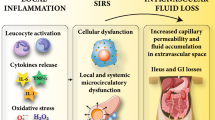Summary
During recent years it has been recognized that the gut can play a crucial role in the pathophysiology of various disease states in the critically ill, not only as a “victim” of systemic illness but it can act both as a source or a “mover”, can initiate and perpetuate systemic infections and/or the multiple organ dysfunction syndrome (MODS). In this “gut hypothesis” of the development of systemic infections and/or septicemia, it is postulated that both local factors (direct injury to the mucosal wall) and systemic insults (such as hypotension) impair the mucoval integrity and barrier function of the intestinal wall and can cause invasion of viable microorganisms, of endotoxin or other macromolecules into the lymphatic system and ultimately into the systemic circulation (“intestinal translocation”). Especially in the patients with compromised immunocompetence, this process can finally result in inflammatory response or even in evolution of systemic infections.¶ Consequently, strategies to maintain various intestinal functions, to support the intestinal barrier and to prevent or reduce bacterial translocation have become one of the pillars in the treatment of intensive care patients. In this respect, unspecific measures and the general management of the patient, such as maintenance of perfusion, oxygenation and motility, avoidance of inappropriate antibiotic therapy, are of utmost importance. The most important and most effective measure, however, is enteral nutrition. The avoidance of an exclusively parenteral nutrition and the early initiation of enteral nutrition, which stimulates and supports a broad pattern of intestinal functions has become a central therapeutic approach in the management of critically ill patients. Several nutrients such as glutamine, arginine or nucleotides may specifically help to support gastrointestinal defense functions (“immunonutrition”). In contrast – but similar to the therapy of sepsis – more specific pharmacologic interventions have not achieved any major importance in the clinical situation.
Zusammenfassung
Der Darm – lange Zeit in der Intensivmedizin vernachlässigt – stellt ein ganz wesentliches Organsystem für den kritisch kranken Patienten dar. Der Gastrointestinaltrakt ist sowohl als „Ursprung” als auch „Motor” von systemischen Infektionen, für Auslösung oder Persistenz einer Sepsis und/oder eines multiplen Organversagens erkannt worden. In dieser„Darm-Hypothese” der Sepsis-Entstehung wird postuliert, dass sowohl lokale Faktoren (direkte Schädigung der Mukosa) als auch systemische Insulte (wie z.B. eine Mangeldurchblutung) die zelluläre Integrität und die Barrierefunktion der Darmwand beeinträchtigen und das Eindringen von intakten Mikrooganismen, von Anteilen von Mikroorganismen (z.B. Endotoxin) oder anderen Makromolekülen in das Lymphgefäßsystem bzw. in die Zirkulation fördern („intestinale Translokation”), was schließlich – insbesondere bei Patienten mit beeinträchtigter Immunkompetenz – zur Ausbildung einer inflammatorischen Reaktion bzw. systemischer Infektionen führen kann.¶ Die Aufrechterhaltung bzw. die Wiederherstellung der intestinalen Funktionen ist damit zu einem der Eckpfeiler in der Behandlung jedes Intensivpatienten geworden. Therapeutische Strategien umfassen unspezifische Maßnahmen und das allgemeine Management des Patienten, wie die Aufrechterhaltung der Perfusion, Oxigenierung und Motilität und eine fachgerechte Antibiotikatherapie. Am wichtigsten jedoch ist der (frühe) Beginn einer – zumindest partiellen – enteralen Ernährung, durch die ein breites Spektrum verschiedener intestinaler Funktionen stimuliert wird. Möglicherweise können spezifische Nährstoffe, wie Glutamin, Arginin oder Nukleotide, die Immunkompetenz und Abwehrfunktion des Gastrointestinaltraktes speziell unterstützen („Immunonutrition”). Im Gegensatz dazu haben – wie etwa auch in der Therapie der Sepsis – spezifischere pharmakologische Interventionen bis jetzt keinen wesentlichen Stellenwert erlangt.
Similar content being viewed by others
Author information
Authors and Affiliations
Additional information
Eingegangen: 15. Januar 2001 /Akzeptiert: 2. April 2001
Rights and permissions
About this article
Cite this article
Druml, W. Klinische Strategien zur Prävention der bakteriellen Translokation bei kritisch kranken Patienten. Intensivmed 38, 638–646 (2001). https://doi.org/10.1007/s003900170014
Issue Date:
DOI: https://doi.org/10.1007/s003900170014




